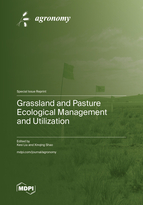Grassland and Pasture Ecological Management and Utilization
A special issue of Agronomy (ISSN 2073-4395). This special issue belongs to the section "Grassland and Pasture Science".
Deadline for manuscript submissions: closed (30 September 2023) | Viewed by 28997
Special Issue Editors
Interests: grassland and pasture ecology and their management and utilization; the restoration of degraded grassland and soil systems; the sustainable management of agro-pastoral coupling systems
Interests: restoration and reconstruction of degraded ecosystems; ecosystem management; biodiversity conservation; sustainable use of natural resources; nutrient regulation and management of grass and livestock systems
Special Issue Information
Dear Colleagues,
Grasslands are one of the most important terrestrial ecosystems, providing multiple ecological functions and services, including livestock production, biodiversity conservation, the maintenance of soil and water, carbon sequestration, and wildlife habitat, among other functions. Many factors affecting grassland ecological management and utilization alter the functions and services provided by this ecosystem. Contributions to this Special Issue should focus on the latest findings regarding the influence of various factors on grassland and pasture functions and services in relation to the ecological management and utilization of these environments. Papers should aim to elucidate the inner mechanisms of change or propose tangible solutions to support sustainable and rational use of grassland and pasture.
“Grassland and pasture ecological management and utilization” will host original research articles and reviews on grassland management and its current and future challenges with respect to global change and landscape features. Potential topics include, but are not limited to: grassland and pasture management, grassland conservation and restoration, ecosystem services, and grassland monitoring and assessment.
Dr. Kesi Liu
Prof. Dr. Xinqing Shao
Guest Editors
Manuscript Submission Information
Manuscripts should be submitted online at www.mdpi.com by registering and logging in to this website. Once you are registered, click here to go to the submission form. Manuscripts can be submitted until the deadline. All submissions that pass pre-check are peer-reviewed. Accepted papers will be published continuously in the journal (as soon as accepted) and will be listed together on the special issue website. Research articles, review articles as well as short communications are invited. For planned papers, a title and short abstract (about 100 words) can be sent to the Editorial Office for announcement on this website.
Submitted manuscripts should not have been published previously, nor be under consideration for publication elsewhere (except conference proceedings papers). All manuscripts are thoroughly refereed through a single-blind peer-review process. A guide for authors and other relevant information for submission of manuscripts is available on the Instructions for Authors page. Agronomy is an international peer-reviewed open access monthly journal published by MDPI.
Please visit the Instructions for Authors page before submitting a manuscript. The Article Processing Charge (APC) for publication in this open access journal is 2600 CHF (Swiss Francs). Submitted papers should be well formatted and use good English. Authors may use MDPI's English editing service prior to publication or during author revisions.
Keywords
- grassland
- pasture
- nutrient management
- grazing management
- restoration
- climate change
- ecosystem services
- soil quality
- forage quality
- grassland monitoring and assessment







